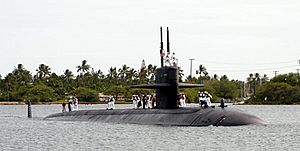Nuclear submarine facts for kids
A nuclear submarine is a special type of submarine that gets its power from a nuclear reactor. This powerful engine lets nuclear submarines travel very fast and stay underwater for a long time. Unlike regular submarines, many nuclear submarines never need to refuel for their entire 25-year lifespan. This means they can stay on missions for months without stopping.
Contents
How Nuclear Submarines Work
Nuclear submarines use a nuclear reactor to create heat. This heat boils water, making steam. The steam then spins large turbines, which turn the submarine's propellers. This process is very efficient and provides a huge amount of energy.
The reactor also powers all the other systems on the submarine. This includes lights, air conditioning, and equipment for life support. Because they don't need to carry large amounts of fuel, nuclear submarines can stay underwater for a very long time.
Advantages of Nuclear Power
Nuclear power gives submarines many big advantages. They can travel much faster than diesel-electric submarines. They can also stay submerged for months at a time. This is because they don't need to come to the surface to get air for their engines.
This ability to stay hidden underwater for long periods is very important for military missions. It makes nuclear submarines very hard to detect. They can travel around the world without needing to stop for fuel.
Types of Nuclear Submarines
There are two main types of nuclear submarines. These are attack submarines and ballistic missile submarines. Each type has a different main job.
Attack Submarines
Attack submarines are designed to hunt other submarines and ships. They carry torpedoes and sometimes cruise missiles. Their main goal is to protect fleets or attack enemy vessels. They are very fast and quiet, making them excellent hunters.
Examples include the American Los Angeles-class and Virginia-class submarines. The British Royal Navy has Astute-class attack submarines. Russia also operates several classes of nuclear attack submarines.
Ballistic Missile Submarines
Ballistic missile submarines (often called SSBNs) are much larger. Their main job is to carry and launch ballistic missiles. These missiles can carry nuclear warheads. SSBNs are a key part of a country's nuclear defense.
They are designed to stay hidden for long periods. This ensures they can launch their missiles if needed. The American Ohio-class and Russian Borei-class are examples of these powerful submarines.
Famous Nuclear Submarines
The first nuclear-powered submarine was the USS Nautilus. It was launched by the United States in 1954. The Nautilus was a huge step forward in submarine technology. It showed the world what nuclear power could do.
Another famous submarine is the Russian Typhoon-class. These are the largest submarines ever built. They are known for their massive size and ability to carry many ballistic missiles.
Safety and Environment
Nuclear submarines are built with many safety features. The nuclear reactors are designed to be very safe. When a nuclear submarine is retired, its reactor is carefully removed. It is then safely stored to prevent any environmental harm.
The crews on nuclear submarines are highly trained. They follow strict rules to ensure safety. This includes handling the reactor and all other systems on board.
Images for kids
-
USS Nautilus, the first nuclear-powered submarine.
See also
 In Spanish: Submarino nuclear para niños
In Spanish: Submarino nuclear para niños
















